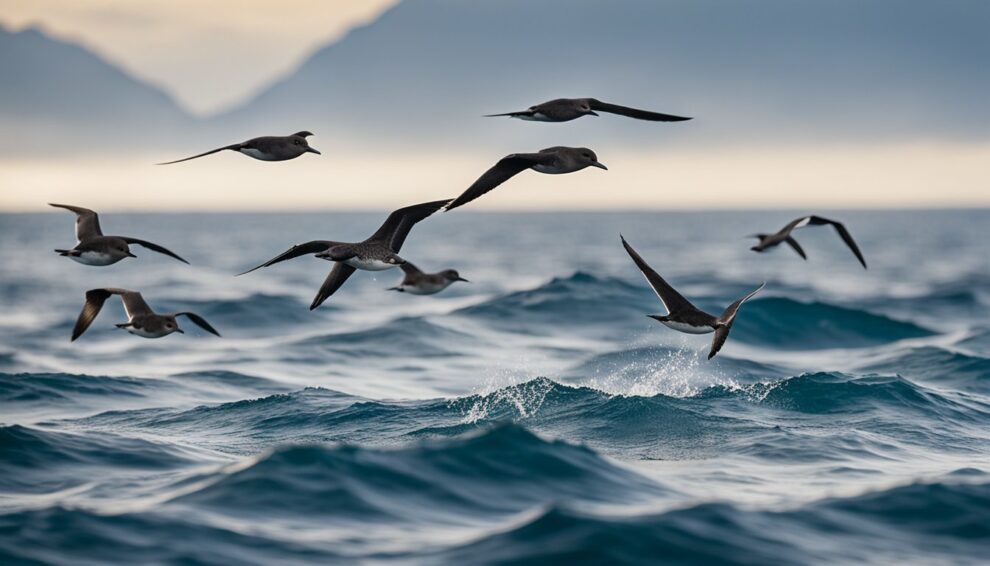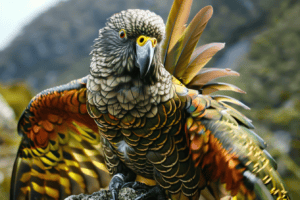Imagine a bird that travels the equivalent of 1.5 times around the Earth in a single year. Meet the Sooty Shearwater, a true marvel of migration.
They’re the intrepid aviators of the animal kingdom, embarking on one of the longest migrations documented for any creature.
These unassuming, dark brown birds with the glimmer of silver on their underwings are not just winging it; they’re on a well-calculated global odyssey in search of endless summer, chasing favorable seasons to find food and breeding grounds.

During their epic journey, Sooty Shearwaters cover an astonishing distance of approximately 39,000 miles.
Can you believe they fly such great lengths without modern GPS?
They navigate using the natural cues of the world, like the sun, stars, and even the Earth’s magnetic field.
And it’s not a leisurely flight either; these birds mean business.
They dip and dive through the air, just above the waves, then plunge deep beneath the ocean’s surface to snatch their prey.
Their migration is not just a show of stamina, but also a fine-tuned strategy to survive and thrive.
Every year, they leave their breeding grounds in the Southern Hemisphere and split the skies across the Pacific Ocean.
They don’t just go anywhere; individual birds target specific ocean hot spots off coasts as distant as California, Alaska, and Japan, each rich with the promise of plentiful food.
And when their feeding frenzy in the Northern Hemisphere ends, they wing their way back south, completing their globe-spanning round trip.
Isn’t it amazing how these birds experience summer twice a year, basking in the best of the sun’s offerings no matter where they are in the world?
The Sooty Shearwater’s Astonishing Journey
The Sooty Shearwater embarks on an epic interhemispheric flight annually, showcasing one of the animal kingdom’s most impressive migratory feats.
Mapped Routes and Mysteries Unveiled
The Sooty Shearwater, a medium-sized seabird hailing from New Zealand, has long intrigued scientists with its sophisticated navigational skills.
With the advent of electronic tags, researchers have illuminated the shearwaters’ migration pattern, revealing a figure-8 route across the Pacific and Atlantic oceans that challenges former theories of random, widespread travel.
These birds fine-tune their journey by strategically selecting one out of the three prominent feeding hotspots.
Can you imagine choosing just one favorite vacation spot if you could go anywhere?
Stunning Distances and the Quest for Summer
Shearwaters are in constant pursuit of summer, chasing temperate climates from the Southern Hemisphere to feeding grounds as far-reaching as California and the Arctic.
The distances they cover are jaw-dropping, with an average of 40,000 miles journeyed each year.
That’s like flying around the Earth’s equator one and a half times!
Along their route, these indefatigable fliers use the Antarctic’s fierce winds to propel themselves, making their long-haul flights more energy-efficient.
Why do they go to all this trouble? It all revolves around food and having a cozy place to raise their chicks.
The Antarctic provides an ample buffet that helps them bulk up for the breeding season in the Southern Hemisphere.
Isn’t it fascinating how their lives are a non-stop adventure of catching waves and chasing sunsets?
Through their relentless pursuit across hemispheres, sooty shearwaters embody nature’s magnificent design for endurance and survival, always on the move, from the depths of the southern oceans to the northernmost edges of the Earth.
Avian Athletes: Masters of the Sky and Sea

The Sooty Shearwater is an incredible navigator of both sky and sea, known for its jaw-dropping migrations and underwater hunting prowess.
Aerodynamics and Oceanic Acrobatics
The Sooty Shearwater is a master of the air, utilizing its long, narrow wings spanning up to 109 centimeters to slice through the wind with remarkable efficiency.
It’s not only the sky where they excel. These seabirds are equally adept underwater, flapping their wings with precision to dive up to 68 meters.
When it comes to exploiting the ocean’s bounty, they exhibit a unique aerodynamic advantage.
They blend the physics of air and water to skilfully ‘shear’ the waves and can plunge from the air into the sea in a seamless, swift motion, pursuing their prey to remarkable depths.
The Diet of an Ocean Wanderer
When mealtime calls, the Sooty Shearwater is on the hunt for a buffet of marine delicacies.
It targets schools of fish, clouds of squid, and swarms of krill.
Their diet is rich and varied, and these savvy hunters are skilled at locating their next meal, often feeding at night when many species of fish come closer to the surface.
A Sooty Shearwater’s day might include snatching a squid or two, followed by a banquet of small fish, and perhaps a side dish of krill.
Their diverse menu sustains them through their long, ocean-spanning flights and deep dives, fueling their extraordinary expeditions across the globe.
Conservation Challenges: Thriving Against the Odds

The Sooty Shearwater’s global journey is not without peril.
As they navigate the vast oceans, they encounter a multitude of challenges that threaten their survival and impact their populations.
Threats from Land and Sea
Population Declines Amidst Natural Predators: Sooty Shearwaters are part of a complex ecosystem where they must evade various predators.
From large seabirds that target their young to agile sea predators that hunt them during their deep dives, life isn’t easy for these travelers.
Climate Change – The Invisible Adversary: Despite their mastery of the skies and seas, Sooty Shearwaters can’t outfly climate change.
Warming ocean waters and shifting weather patterns unpredictably affect their food sources, making it difficult for them to find nourishment and preserve their energy for the long migrations.
Human Impacts and the Fight to Flourish
Habitat Degradation on Breeding Grounds: When they return to land to lay their eggs and raise their chicks, they face habitats that are no longer as welcoming as they once were.
Human activities, such as land development, introduce new challenges for nesting and raising their young.
Plastic Pollution – A Sea of Harm: The oceans are littered with plastic, and for a Sooty Shearwater, mistaking these floating dangers for food can be fatal.
Ingesting plastic not only harms individual birds but can also lead to significant population declines over time.
The Role of Conservation Status: Recognized as near threatened on the IUCN Red List of Threatened Species, the Sooty Shearwater’s decreasing numbers signal it’s time for action.
Efforts to mitigate these threats and promote conservation are the keys to ensuring these amazing birds continue to grace our skies.
Can you imagine a world without the Sooty Shearwater’s majestic flight over the waves?
It’s up to us to help write a hopeful chapter in their odyssey.
Through learning and supporting conservation efforts, we contribute to their story of resilience.
The Cultural and Scientific Significance of Sooty Shearwaters

The Sooty Shearwater, known as tītī to Maori and muttonbird in common vernacular, connects cultures and provides invaluable insights into seabird ecology.
Nowhere is this connection more evident than in the bird’s cultural standing and the scientific community’s pursuit of knowledge.
From Cultural Icon to Scientific Marvel
In the realm of cultural significance, the Sooty Shearwater holds a special place.
For the indigenous Maori of New Zealand, these birds are not just wildlife—they’re tītī, integral to traditional customs and a staple food source.
Every year, Maori communities engage in the sustainable harvest of young shearwaters, or muttonbirds, using methods passed down across generations.
This practice has maintained its place in the annals of tradition, interweaving the lives of these remarkable birds with human culture.
These cultural interactions open a gateway for scientists to study the birds more closely.
Eager researchers harness genetics to unlock the mysteries of migration and adaptation.
Like detectives combing through clues, they examine the Sooty Shearwater’s DNA, finding answers to how these birds perform their global odyssey.
Their findings, often published in prestigious journals such as the Proceedings of the National Academy of Sciences, shed light on how shearwaters, and perhaps other species, navigate vast oceans in pursuit of small fish, their primary prey.
The Future of Research and Understanding
As environmental challenges loom and climates shift, scientists transform into guardians of knowledge, piecing together how such changes might affect the long journeys of these winged wanderers.
They ask questions, like how will shearwaters adapt to shifting fish populations, or what secrets does their genetic code hold to their resilience?
The growing body of research not only contributes to academic understanding but also informs conservation strategies ensuring these birds continue to grace our skies for generations.
Meanwhile, researchers are just scratching the surface of the shearwaters’ enigmatic existence.
As they continue to study these birds, they hope to draw from the deep well of genetic, ecological, and environmental data to paint a clearer picture of the shearwaters’ lives—knowledge that can secure the future not only for tītī but for the global ecosystem they inhabit.
The ongoing dance between cultural practice and scientific study perpetuates a relationship of respect and fascination, encouraging the protection of these birds as symbols of nature’s intricate connections.
Frequently Asked Questions

The Sooty Shearwater’s migratory quest is a tale woven across vast oceans.
Curious minds often ponder about their incredible journey and its details.
Let’s explore the most common inquires.
How far can a Sooty Shearwater travel during its migration journey?
The endurance of Sooty Shearwaters during migration is nothing short of astonishing. They travel up to 60,000 kilometers (about 37,282 miles) annually.
This sheer distance is akin to embarking on a global tour each year!
What are the main reasons for the long-distance migration of Sooty Shearwaters?
They migrate such long distances mainly to exploit seasonal food resources and to breed.
As the seasons change, so do the availability of food sources like fish and squid.
Their journey ensures they’re always at the right place for a hearty meal and a safe spot for raising their chicks.
How do Sooty Shearwaters navigate across oceans to find their way during migration?
These birds are expert navigators. Sooty Shearwaters use the sun, stars, and Earth’s magnetic field to orient themselves.
Imagine having a built-in compass and map – that’s how they can traverse the vast and open sea without getting lost.
At what time of year do Sooty Shearwaters usually begin their migration?
Migration timing is critical.
Sooty Shearwaters usually start migrating in October from their breeding colonies in the Southern Hemisphere to the richer feeding grounds of the North.
When the northern summer beckons, it’s time for them to cross oceans yet again.
Can you explain the differences between Sooty Shearwater migration and that of similar seabirds like the albatross?
While both the Sooty Shearwater and the albatross are known for their extensive journeys, Sooty Shearwaters tend to fly at lower altitudes and can dive deep underwater in search of food.
Albatrosses rely more on gliding and wind patterns for their travel, soaring higher and often covering longer distances without flapping as much.
What impact does the Sooty Shearwater’s migration have on the marine ecosystems they travel through?
Their migration has a significant ecological role; these birds help maintain the balance of their marine habitats.
As they move, they distribute nutrients via their droppings, supporting the ocean food chain.
They even contribute to the health of phytoplankton – tiny plants that serve as the ocean’s lungs by producing oxygen.
Discovering the Sooty Shearwater’s journey is like uncovering the pages of a natural travelogue, with each destination playing a crucial role in their survival and the planet’s marine health.









